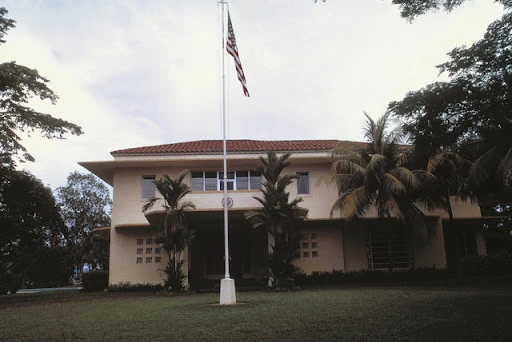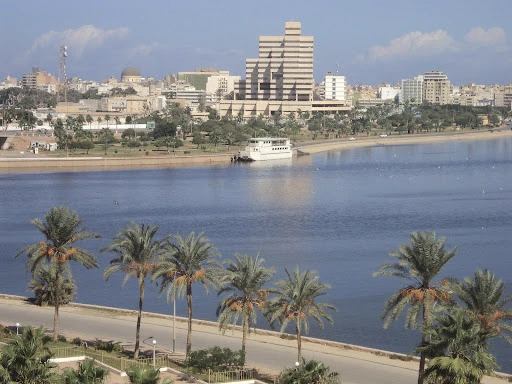No symbol more iconically represents the United States abroad than its flag, the Star Spangled Banner. Whether planted on the surface of the moon, flown over U.S. embassies, or worn on military uniforms, the flag serves as a universal beacon of freedom and democracy. U.S. Foreign Service Officers who serve our country around the world play a critical role in upholding these values.
In the history of U.S. diplomacy, diplomats have witnessed the gamut of experiences with the flag, ranging from celebrations of warm relations with foreign nations to heroic efforts to keep the Stars and Stripes flying. This collection of excerpts presents key highlights in which the flag played a role of particular import in the stories of U.S. Foreign Service Officers.
Drafted by Benjamin Manens
ADST relies on the generous support of our members and readers like you. Please support our efforts to continue capturing, preserving, and sharing the experiences of America’s diplomats.
Excerpts:
Robert L. Funseth
Bordeaux, France—Consular Officer (1961–1964)
Robert Funseth was interviewed by Charles Stuart Kennedy on June 13, 1994
Read Robert Funseth’s full oral history HERE.
“American flags all over Bordeaux! Ordinary people had faded flags; banks had flags! We were the only foreign flag flown over the city hall at Bordeaux on our National Day!”
Fourth of July 1961 in Bordeaux:

But it also demonstrated to me within a month or two after I arrived there, that there was great affection and admiration in that area towards the United States. On the Fourth of July, spontaneously, not organized, I remember going down—I’d heard about it but no one had really said anything—driving down to hoist a large American flag in front of the consulate on the fourth of July. American flags all over Bordeaux! Ordinary people had faded flags; banks had flags! We were the only foreign flag flown over the city hall at Bordeaux on our National Day! Huge American flag flying over the city. It was affection and admiration and real genuine feelings towards the United States.
Joseph Farland
Panama—Ambassador (1960–1963)
Joseph Farland was interviewed by Charles Stuart Kennedy on January 31, 2000.
Read Joseph Farland’s full oral history HERE.
“When I told Eisenhower that, he said, ‘What are you going to do about it?’ I said, ‘I’m going to put the flag up.’”
Restoring U.S. Embassy Panama in 1960:

FARLAND: The first morning I got there, I went down to the embassy and walked in the front door. There was no American flag flying. That was a very important point. There was no American flag flying in front of the American embassy. This Marine was standing there and I said, “I have trouble finding this embassy. Usually, there is an American flag flying. This is the American embassy?”
He said, “Yes, Sir.” I said, “Why isn’t there an American flag flying?” He said, “That is the ambassador’s orders, Sir.” I said, “Listen, Gyrene, I’ve got news for you. I’m the American ambassador and when I present my credentials, I want that flag on that flagpole. Does that suit you?” He said, “Yes, Sir” and that is the way we had one upstairs. From then on, it was all history.
Q: Why hadn’t the flag been flown?
FARLAND: The ambassador was afraid they’d tear it down. When I told Eisenhower that, he said, “What are you going to do about it?” I said, “I’m going to put the flag up.” He said, “You’d better God damn well do that.” I said, “I intend to. We’ve got a lot of flags to keep flying.”
John G. Kormann
Benghazi, Libya—Principal Officer (1966–1968)
John Kormann was interviewed by Moncrieff Spear on February 7, 1996.
Read John Kormann’s full oral history HERE.
“Afterward I said, ‘Go ahead, raise the flag!’ He did so with considerable daring, the mob going crazy below and the rocks flying.”
1967 Riots in Benghazi:
I might mention something here, because many people asked me about it afterward. At one point the mob used a ladder to drop from an adjoining building onto our roof, catching us trying to burn files there. After a struggle they drove us back into the Embassy. They cut the ropes on the tall roof flag pole, leaving the flag, itself, hanging down the front of the building. An Army MAAG captain, who was with us, requested permission to go up on the roof and raise the flag.

I dismissed his request, saying it would be counterproductive. Later when things looked very bleak and our spirits were waning, he came to me again in front of the others. I told him I would think about it. I had been a combat paratrooper in WWII and had seen what defiance and a bit of bravura could do for soldiers under mortal stress. Afterward I said, “Go ahead, raise the flag!” He did so with considerable daring, the mob going crazy below and the rocks flying. The reaction among my people was profound. I could see it in their eyes, as they worked on with grim determination under those conditions to burn files and render cryptographic equipment inoperable….
Lucy Barnard Briggs
Accompanied husband Ellis Ormsbee Briggs, U.S. Ambassador to Czechoslovakia (1949–1952)
Lucy Briggs was interviewed by Patricia Squire on October 16, 1989.
Read Lucy Briggs’ full oral history HERE.
“…the American flag probably means a great deal more to Foreign Service people than civilians can ever imagine.”
Christmas 1949 in Prague:

BRIGGS: Yes, and of course the most extraordinary memory I have of Czechoslovakia was on a New Year’s Day when we went down to the famous church in the center of the city to the New Year’s Day service. It was very full of Czech people. I went with the wife of the Chargé, Ruth Thompson . . . .
And as we started to leave the church, we found the people going out very slowly. It was almost like a jam.
We followed them slowly. I remember Ruth Thompson saying to me, “Do you suppose it’s our car that’s doing this?” Our car, of course, had an American flag on it. We never went anywhere without the American flag on the car. And we got to the doorway and looked down the long flight of stairs to the street, and there was our car at the bottom of the steps. The square in front of the church was absolutely full of people. All over, on the sidewalks, in the street, all around the car. This was somewhat alarming, because what were they going to do? So all of us quickly got down to the car. But people around us began to wave to us. And men took their hats off and I saw people crying. It was terribly moving, especially because nobody made a single sound. And we rode absolutely silently back to the house. It was an extraordinary experience.
Q: You had the flag flying also on top of the Chancery?
BRIGGS: Yes, we always did. Flying high up above everything.
Q: And they looked down from the castle on it.
BRIGGS: Which reminds me that the American flag probably means a great deal more to Foreign Service people than civilians can ever imagine.
Q: At times like that. On the Fourth of July.
BRIGGS: On the Fourth of July. Or just to see it there in the midst of everything.
